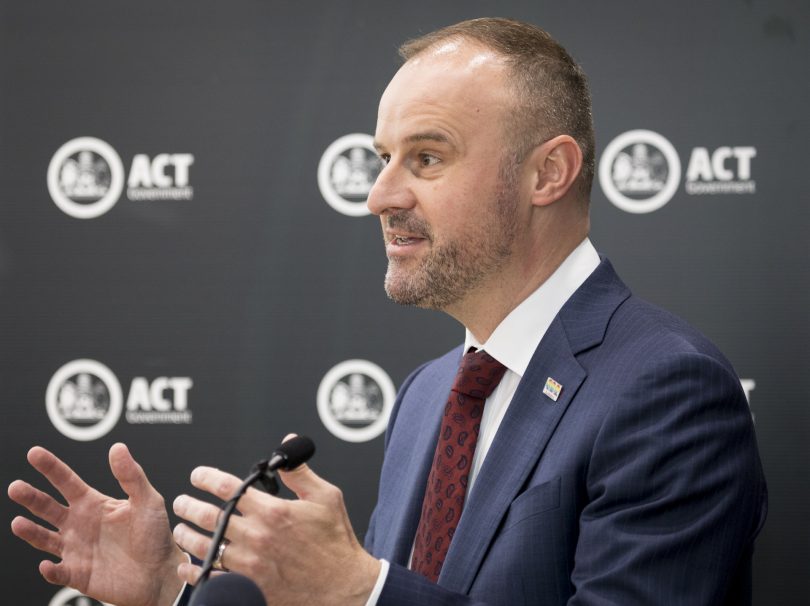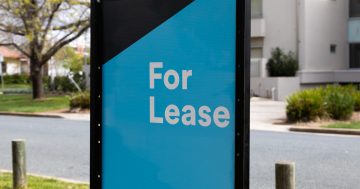
Chief Minister Andrew Barr is looking to “screwdriver ready” projects to help the ACT economy recover post-COVID-19. Photo: File.
Australia has bought itself more time, but it cannot be complacent in its fight against COVID-19, the Prime Minister said today.
The dual health and economic impacts of the crisis formed part of the Prime Minister’s national address and Chief Minister Andrew Barr’s response, including the ACT’s plans to appoint a COVID-19 local business commissioner.
For the first time today, the Prime Minister also provided insight into the data the government was using to base its decisions on after today’s National Cabinet meeting.
The two sets of modelling undertaken by the Doherty Institute detailed the absolute worst-case scenario and used international data for its predictions. Mr Morrison stressed this result was not directly applicable to Australia’s situation as we have implemented a range of measures that have already seen the curve flatten.
“It is not based on Australian case data and it is not modelled on Australia’s responses,” Mr Morrison said.
The modelling found that in a worst-case scenario, Australia’s health system would be overwhelmed in a matter of weeks with the daily demand for new intensive care beds exceeding 35,000, meaning only 15 per cent of people requiring ICU beds would get one.
Quarantine and isolation would flatten the curve and reduce the proportion of people who would catch the virus to 68 per cent, and those needing medical care to 29 per cent. The end result would be reduced demand on ICUs.
The modellers looked at two levels of social distancing on top of quarantining and isolating.
A drop in the transmission rate of 25 per cent due to social distancing would see under 40 per cent infected and 16 per cent requiring medical care while a drop of 33 per cent in the transmission rate would see rates drop to 12 per cent and five per cent respectively.
“It is important to understand these models are highly theoretical and not predictions,” Australia’s Chief Medical Officer Dr Brendan Murphy said.
Australia is faring well compared with other countries: the daily increase is dropping to single-digit percentages, down from a high point of 27 per cent on 22 March.
The ACT has recorded just one new case of COVID-19 in the past 24 hours.
Earlier today Health Minister Rachel Stephen-Smith said more detailed breakdowns of the local COVID-19 data would be released on the ACT Health website in the coming days, but stressed it would not be broken down to a postcode level in order not to mislead the public about potential infection hotspots.
Commercial leases were also on the National Cabinet agenda as the Prime Minister announced that a mandatory code of conduct would now regulate commercial tenancies. The new code will apply to tenancies where the business is eligible for the Job Keeper program and has a turnover of less than $50 million.
Landlords will not be allowed to draw upon a tenant’s securities but tenants must honour the lease where they can. A reduction in rent should be in proportion to the reduction in revenue or turnover and the new agreement between landlords and tenants will be a combination of reductions and deferrals
At least 50 per cent of this must be a reduction, while any deferrals must be spread over the remaining time of the lease and for no less than 24 months – unless otherwise agreed to by both parties.
“The Code provides a proportionate and measured burden share between the two parties while still allowing tenants and landlords to agree to tailored, bespoke and appropriate temporary arrangements that take account of their particular circumstances,” Mr Morrison said.
“It preserves the lease and the relationship.”
Chief Minister Andrew Barr confirmed that eligibility criteria would be capped at $50 million in the ACT, as the Government’s own stimulus measures will work to complement the Federal stimulus and not stand to be mutually exclusive.
Residential tenancies will be directly dealt with by state and territory governments.
The Chief Minister said the ACT would be looking to the Federal Government for help over the course of the pandemic, saying that the Commonwealth’s most recent stimulus package – worth $130 billion – was 20 times larger than the Territory’s annual budget.
But while the ACT is facing a significant downturn in GST allocations, the Chief Minister said that money already provisioned in the ACT Budget and mid-year update could be allocated to new “screwdriver ready” infrastructure projects like maintenance and repair work that are ready to begin immediately.
These projects would also feed into the Territory’s $20 million job fund for Canberrans which looks to give work to people who have fallen between the cracks of the JobSeeker and JobKeeper payments, such as casual workers.





















